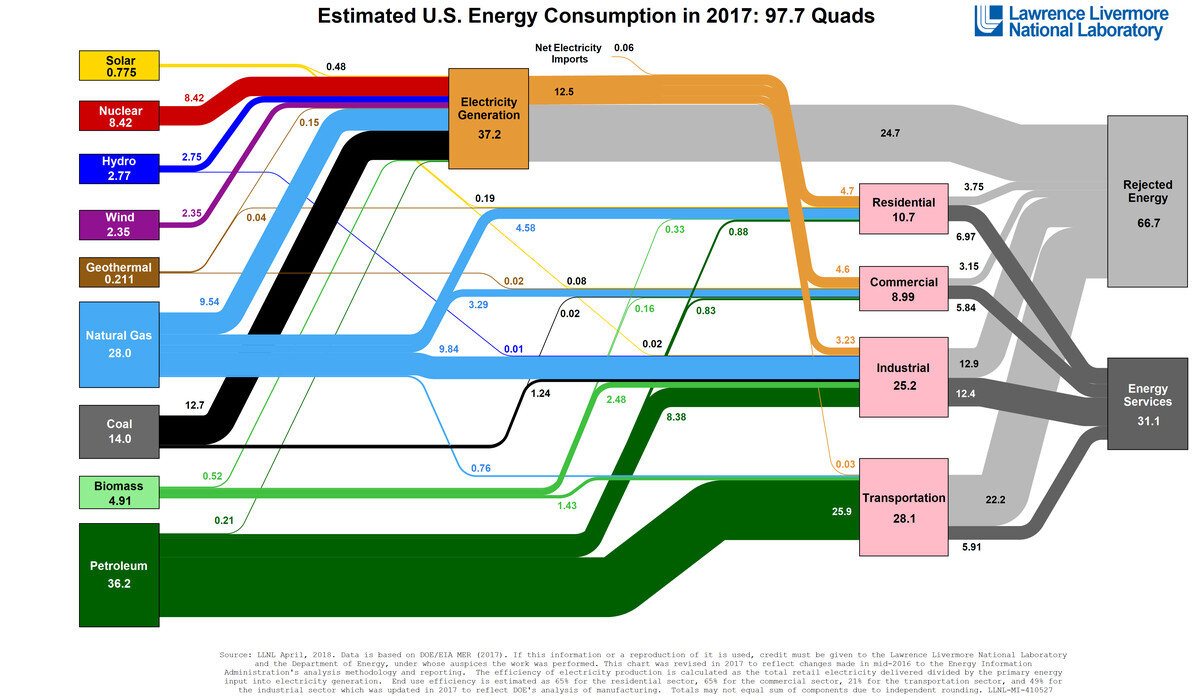Is There Enough Biomass to Fuel the World? Part II
How much energy do we need and what do we use it for?
Summary - The world needs 435 TWh of energy per day, of which 87% comes from fossil fuels. Energy is needed in 3 sectors, for 3 purposes (3x3 rule). The sectors are transportation, industry and buildings. We use energy for heating, transport and electricity purposes. Depending on the region, most of our energy is required in the transportation sector and for heating purposes.
Biomass: essentially solar-powered batteries provided by nature. For free. Winning! This second part of our three-part series will be mostly about energy though. Check out the first part for everything you need to know about biomass.
In the debate surrounding the energy transition, there is one question that nobody seems to be asking:
How much energy do we need in the first place? What exactly are the types of energy that we use and what do we use it for?
Ok, this is more than just one question. Nonetheless, providing answers to these questions is essential if we are to transform our energy system into a sustainable one. Even more so as we are trying to determine whether there is enough biomass to fuel the world in such a system.
In this second part of a three-part series on biomass, we will learn all there is to know about energy. In particular: how much energy do we need and what do we use it for in the first place?
All you need to know about energy
How much energy do we need?
The entire world needs a total of 435 TWh* of energy per day, of which the majority (87%) comes from fossil fuels. These are crude oil (35%), coal (28%) and natural gas (24%). A small portion is coming from traditional biofuels (7%), which is mostly made up of woody biomass. The energy need of the world is referred to generally as the global primary energy consumption. In more practical terms, what we need per day is roughly 100 million barrels of oil, 21 million metric ton of coal and 10 billion cubic meters of gas according to worldometer. Our consumption of energy has skyrocketed since World War II, after industrialization really kicked in. Especially the consumption of crude oils and gas increased, as can be seen in the figures below.
*A TWh is 1.000.000.000.000 Watt-hour, the official unit of power. I’ll explain later.
Now I hear you thinking:
You are correct. It is hard for most of us to visualize these numbers. These kind of large figures do not represent a real tangible value to most people and apart from expressing them in barrels of oil or tons of coal, there is not much I can do to help you understand them better. Nonetheless they are required in the debate surrounding the energy transition as they are the factual basis for any discussion later on. For now however, we just need to remember two things:
We need a LOT of energy, 435 TWh per day.
Virtually all the energy we currently use is fossil-based.
How then can we understand our energy needs better? Perhaps we should be looking into what we need the energy for, instead of simply looking at the total amount of energy we need.
Where do we consume our energy, and what do we need it for?
Despite what people might tell you, our energy needs are actually pretty basic. Energy is needed in 3 places to do 3 things. This is what I call the ‘3x3 energy rule’. Let me explain.
Energy consumption can be divided into three different sectors, and is used for only (!) three distinct purposes. The sectors are transportation, industry and buildings. The purposes are electricity, heat and transport.
3 Sectors - where energy is spent
Transportation would be, you guessed it, transportation of goods and humans on land, air and sea. Energy in this sector is mostly used by burning a petroleum-based fuel inside a combustion engine.
Industry is where most of our stuff is made, including agriculture and chemical industries. Energy in this sector is mostly spent on heating and cooling to very high or low temperatures, for instance in steel mills or chemical plants.
Buildings are the places where most of us live and work, divided into residential and commercial respectively. In buildings, we mostly use energy for heating and cooling spaces, taking nice showers and warming water for cups of tea, or powering devices such as the computer or phone you are reading this blog on.
Depending on where and when you live, each sector is responsible for approximately 33% of energy demand. In most places however, buildings require slightly less energy in general.
3 Purposes - what energy is spent on
Heat is a collection of all the purposes that include the heating and cooling of stuff. This could be warming your home, cooling your home, or heating/cooling chemical substances like your bread in an industrial bakery.
Transport is the transport of both humans (in cars for example) but also goods (in ships).
Electricity is used for lighting or using tools and equipment, for example powering the device you are reading this on.
Most of the energy we spent is used for heating and cooling. Close to about half of the energy we use is dedicated to this purpose.
Energy Consumption per Sector. Depending on the exact source, country and time, you get a breakdown in energy consumption per sector as show above. Looking at the pie chart, it becomes clear that despite of all the vast numbers of energy carriers and generation methods, we only need energy in 3 places to do 3 things. We need energy in three distinct ‘places’, i.e. transport, industry and buildings. We need it for three distinct purposes, i.e. to heat (or cool), for transportation, and to power our devices and lights in the places we live and work. Above graph is made using the U.S. energy consumption in 2017.
Energy Consumption per Purpose. Energy, for all humans, is spent on only three things: heating, transport and electricity. Heating means changing temperatures of a room or material and thus also includes cooling. An example is a HVAC system, or Heating Ventilating Air-Conditioning system. Transport is the transport of both humans (in cars for example) but also goods (in ships). Electricity is used for lighting or using tools and equipment, for example powering the device you are reading this on. Most of our energy goes to heating and cooling purposes. The numbers are taken from Researchgate and can differ per region.
Overview
How does energy flow to where we need it?
Now that we understand better where and how we spend our energy, the next step is to have a look into how these different energy sources ‘flow’ into useful energy. A common tool to show how energy flows from its source into used energy, is a Sankey diagram. Below is such a diagram for the energy consumption of the U.S. in 2017, where the units are ‘quads’. In this diagram, the energy flows from source (left) to sector (right). One quad represents a certain amount of energy, i.e. one quadrillion (a thousand trillion) British Thermal Units. We have again arrived at stupendous numbers, that sort of goes along with this subject. One quad of coal is roughly equal to 36.000.000 metric tons. Basically, it is so much that it is easier not to stare yourself blind at it. Besides, it is not the size of the numbers but the relationship between the different flows that is important.
Again, we are making things way too complicated. I have therefore made a simplified version of this Sankey diagram to show you the most important energy flows, shown below. If we take a close look at this diagram, we can derive a number of conclusions.
Transportation primarily uses petroleum-based fossil fuels as an energy source. Buildings and industry use a mix of fossil fuels plus electricity. The energy mix for industry is the most diverse, buildings use about 50/50 electricity and fossil fuels, mostly gas.
Coal and renewables are used almost solely for generating electricity.
The role of biomass in the current energy system is negligible.
A simplified Sankey diagram of energy flows, based on the 2017 energy consumption of the U.S. On the left are displayed sources of energy, on the right side are the sectors where energy is used. Energy thus flows from source to sector. This diagram shows that almost 70% of all the energy that we ‘use’ is wasted. Most of the energy is wasted in the form of heat dissipation in combustion engines and during electricity generation. This wasting of energy is a reason to pursue a decentralized energy system, which is explored in part three of this series.
End Result
How much energy do we need and what do we use it for?
The world needs 435 TWh of energy per day, of which 87% comes from fossil fuels. Crude oil is needed the most, after which coal and gas get shared second-place. Depending on the region, most of our energy is required in the transportation sector (slightly more than 33%) and for heating and cooling purposes (slightly less than 50%).
Furthermore, transportation primarily uses petroleum-based fossil fuels as an energy source. Buildings and industry use a mix of fossil fuels plus electricity. The energy mix for industry is the most diverse, buildings use about 50/50 electricity and fossil fuels, mostly gas. Coal and renewables are used almost solely for generating electricity. Finally, it should not go unnoticed that the role of biomass in the current energy system is negligible.
Now that we know everything there is to know about biomass from part I, as well as the amount of energy we need on a daily basis, we can finally look into how biomass can contribute to a sustainable energy future. We will do this in the final part of this series, in which we will find out that we can have our cake and eat it too.
References & Further Reading
Our World in Data - Global primary energy consumption
Worldometers - Gas & Coal consumption
VOX - American energy use
Cleantech - U.S. building sector end use energy consumption
Researchgate - Regional energy consumption by mode of application in 2010



